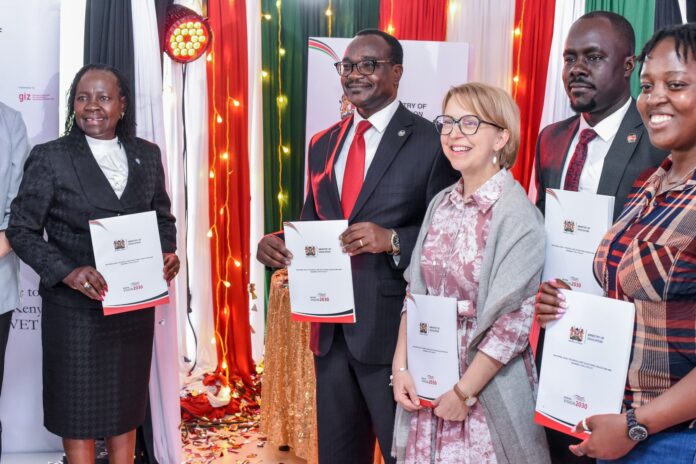Written by Kelly Were
The Kenyan government, in a move with the aim of addressing the nation’s persistent skills gap and high youth joblessness, has officially launched the National Dual Training Policy. The landmark initiative, unveiled at Kiambu National Polytechnic on November 6, 2025, seeks to intimately weave classroom education with practical industry experience, revolutionising the country’s approach to vocational training.
Presiding over the ceremony, Cabinet Secretary for Education Julius Migos Ogamba declared the policy a cornerstone of Kenya’s development agenda. “TVETs remain central to Kenya’s development agenda as the engines of industrial growth and youth empowerment,” CS Ogamba stated. “The Dual Training Policy is one of the boldest steps in reshaping our education system to reflect the realities of the modern economy.” The event was attended by Principal Secretary for Technical and Vocational Education and Training (TVET) Dr. Esther Thaara Muoria and Finland’s Ambassador to Kenya, Her Excellency Riina-Riikka Heikka, signalling international support for the endeavour.
The policy, inspired by successful models in nations like Germany, mandates that trainees split their time between TVET institutions and real-world industry settings. This structured apprenticeship approach is designed to directly align the skills of graduates with the demands of the job market, aiming to prepare over 10,000 trainees annually for meaningful employment. The launch comes against a sobering backdrop of youth unemployment, which recent International Labour Organisation estimates place at approximately 35 per cent for Kenyans aged 15 to 24.
The choice of venue was symbolic, as Kiambu National Polytechnic was recently celebrated at a national awards ceremony for its excellence in dual training and greening initiatives. The institution boasts impressive infrastructure, including a 1.6 million-litre water harvesting system, and serves as a model for the policy’s national rollout. The event itself featured certificate presentations, a plaque unveiling, and a tree-planting activity, underscoring themes of growth and sustainability.
The government is backing the ambitious policy with financial support, highlighted by a recent disbursement of Ksh 441 million in upkeep loans from the Higher Education Loans Board to over 54,000 TVET students. This forms part of a larger Ksh 3.47 billion allocation for the financial year, demonstrating a tangible commitment to strengthening the vocational training sector.
Reaction from industry stakeholders has been positive. Groups such as the Architectural Association of Kenya have welcomed the policy, noting its potential to enhance practical skills in critical fields like architecture, engineering, and landscape design. However, on social media platform X, the announcement was met with a mixture of hope and scepticism. While many celebrated the initiative’s potential, some users voiced broader political grievances, with one critic labelling the government “clowns messing up everything,” and another diverting the conversation to unrelated concerns about teacher intern pay.
The policy’s long-term success will hinge on overcoming several challenges, including securing sustainable funding, fostering deep and consistent collaboration with private industry, and shifting cultural preferences that have traditionally favoured university degrees over vocational qualifications. Drawing lessons from global examples, such as inclusive apprenticeship programmes in Latin America, will be crucial for its tailored adaptation to the Kenyan context.
Ultimately, the launch marks a pivotal moment in the country’s educational landscape. As characterised in a report from educationnews.co.ke, this policy inaugurates “a new era in Kenya’s education landscape: one where skills, innovation, and industry collaboration form the backbone of national development.” The government’s next steps will involve expanding the dual training model from flagship institutions like KINAP to TVET centres across the nation.



















